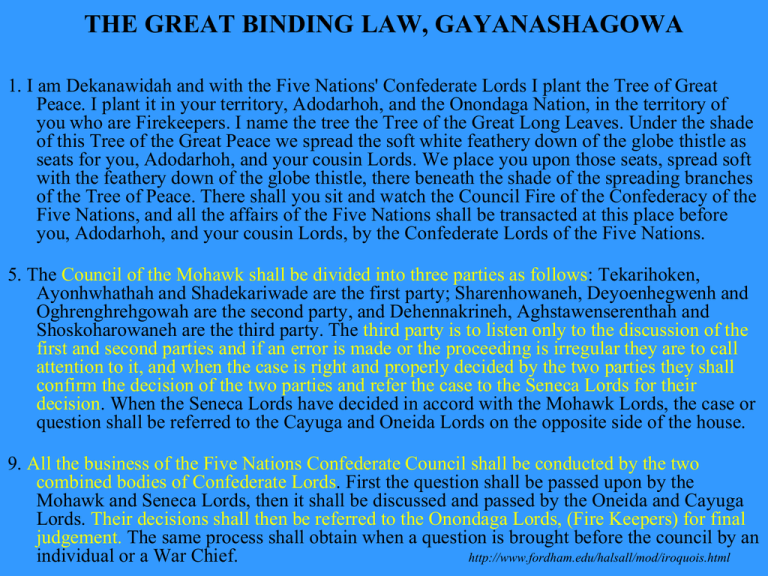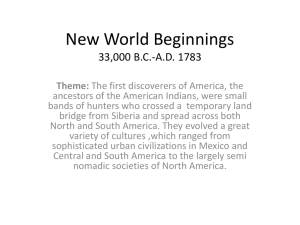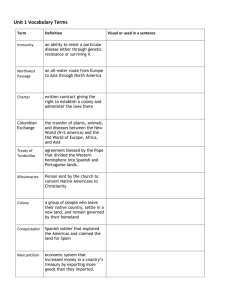
THE GREAT BINDING LAW, GAYANASHAGOWA
1. I am Dekanawidah and with the Five Nations' Confederate Lords I plant the Tree of Great
Peace. I plant it in your territory, Adodarhoh, and the Onondaga Nation, in the territory of
you who are Firekeepers. I name the tree the Tree of the Great Long Leaves. Under the shade
of this Tree of the Great Peace we spread the soft white feathery down of the globe thistle as
seats for you, Adodarhoh, and your cousin Lords. We place you upon those seats, spread soft
with the feathery down of the globe thistle, there beneath the shade of the spreading branches
of the Tree of Peace. There shall you sit and watch the Council Fire of the Confederacy of the
Five Nations, and all the affairs of the Five Nations shall be transacted at this place before
you, Adodarhoh, and your cousin Lords, by the Confederate Lords of the Five Nations.
5. The Council of the Mohawk shall be divided into three parties as follows: Tekarihoken,
Ayonhwhathah and Shadekariwade are the first party; Sharenhowaneh, Deyoenhegwenh and
Oghrenghrehgowah are the second party, and Dehennakrineh, Aghstawenserenthah and
Shoskoharowaneh are the third party. The third party is to listen only to the discussion of the
first and second parties and if an error is made or the proceeding is irregular they are to call
attention to it, and when the case is right and properly decided by the two parties they shall
confirm the decision of the two parties and refer the case to the Seneca Lords for their
decision. When the Seneca Lords have decided in accord with the Mohawk Lords, the case or
question shall be referred to the Cayuga and Oneida Lords on the opposite side of the house.
9. All the business of the Five Nations Confederate Council shall be conducted by the two
combined bodies of Confederate Lords. First the question shall be passed upon by the
Mohawk and Seneca Lords, then it shall be discussed and passed by the Oneida and Cayuga
Lords. Their decisions shall then be referred to the Onondaga Lords, (Fire Keepers) for final
judgement. The same process shall obtain when a question is brought before the council by an
individual or a War Chief.
http://www.fordham.edu/halsall/mod/iroquois.html
What factors were behind
European exploration of the
Americas?
What was the significance of the
Columbian Exchange?
The fate of the Taino…
Bartolomé de las Casas, Bishop of Chiapas - 1542
New Spain was discovered in 1517. …During the 12 years {from 1518 to 1530}
the Spanish killed more than four million men, women, and children with
swords and lances, and by burning people alive…. This does not count those
who have died, and continue to0 die every day, from the slavery and
oppression that the Spanish impose….
Among other massacres perpetrated by the Spanish was one that took place in
Cholula, a city with thirty thousand inhabitants. Dignitaries and priests
from the city and the surrounding countryside greeted the Spanish with
great solemnity and respect, and escorted them into the city and lodged
them in the homes of the local nobility. The Spanish decided to stage a
massacre – or a “chastisement” as they call it – in order to terrorize the
population.
To accomplish this, the Spanish summoned the local dignitaries. As soon as
they arrived to hold talks with the Spanish commander, they were taken
captive and had no opportunity to warn others. Then the Spanish
demanded five to six thousand Indians to carry their loads. ….Once these
poor wretches assembled in the courtyard, guards blocked the gates with the
Spanish soldiers slaughtered the Indians with swards and lances.
The pretext under which the Spanish invaded these areas, massacred their
harmless inhabitants, and depopulated the country was to make the Indians
subjects of the king of Spain.
The Columbian Biological Exchange
Forms of Biological
Life Going From:
Old World to New World:
New World to Old World:
Diseases:
Smallpox
Measles
Chicken Pox
Malaria
Yellow Fever
Influenza
The Common Cold
Syphilis
Animals:
Horses
Cattle
Pigs
Sheep
Goats
Chickens
Turkeys
Llamas
Alpacas
Guinea Pigs
Plants:
Rice
Wheat
Barley
Oats
Coffee
Sugarcane
Bananas
Melons
Olives
Dandelions
Daisies
Clover
Ragweed
Kentucky Bluegrass
Corn (Maize)
Potatoes (White & Sweet Varieties)
Beans (Snap, Kidney, & Lima Varieties)
Tobacco
Peanuts
Squash
Peppers
Tomatoes
Pumpkins
Pineapples
Cacao (Source of Chocolate)
Chicle (Source of Chewing Gum)
Papayas
Manioc (Tapioca)
Guavas
Avocados
| This page was last updated on 12/3/98. | Return to History 111 Supplements | Site Map |
Dr. Harold D. Tallant, Department of History, Georgetown College
400 East College Street, Georgetown, KY 40324, (502) 863-8075
E-mail: htallant@georgetowncollege.edu.
Native American Planting Maize,
from Folio 121 from Histoire
Naturelles Des Indes
Native American Planting Maize, from Folio 121 from Histoire Naturelles Des Indes
Maize (corn), which was genetically engineered by Native Americans in what is now Mexico some 7,000
years ago, became one of the staple food sources for many Indian groups in North America. This sixteenthcentury illustration depicts traditional Native American agricultural practices and typical foods including
corn, squashes, and gourds. (The Pierpont Morogan Library/Art Resource, New York)
Copyright © Houghton Mifflin Company. All rights reserved.
Map: The Spanish and Portuguese Empires
Copyright © Houghton Mifflin Company. All rights reserved.
“El Abrazo” Gonzales Camarena
Objective:
Understand the lasting effects of the Spanish
Conquest of the Americas
http://galeria.50megs.com/gonzalez/el_abrazo.jpg
Map: Europe, Africa, and Southwestern Asia in 1500
Copyright © Houghton Mifflin Company. All rights reserved.
Map: Atlantic Winds and Islands
Copyright © Houghton Mifflin Company. All rights reserved.
Map: Major Mesoamerican Cultures, c. 1000
Copyright © Houghton Mifflin Company. All rights reserved.
Hernan Cortes
Tenochitlan, drawn by Hernan Cortes,
Walters Museum
• Cortes’ attacking force
– 600 men, 17 horses, dogs, and 10
cannons
– Convinced Aztec enemies to fight
with him, greatly aided by his
translator, Malinche
• Secured Cuba
– Landed in Mexico 1519
– Learned of the great wealth in the
regions interior
• Conquered the Aztec Empire
– Held Montezuma, the emperor
hostage for gold
– Eventually sacked and destroyed
Tenochitlan, the Aztec capital
– Had an advantage in
“Guns, Germs, and
Steel”
The Mexican Counterattack, Codex Durán
The Mexican Counterattack, Codex Durán
The differences between European and Native American styles and conceptions of warfare
were often striking. This scene, from the Codex Durán, illustrates a Spanish force besieged by
Aztec warriors. Note the contrast in clothing, for example. For most Indian groups, warfare was
a highly spiritual affair surrounded by ceremony, often involving colorful and fanciful
costumes. The European battle dress, however, bespeaks a very different conception of warfare:
practical and deadly. (Archivo fotografico)
Copyright © Houghton Mifflin Company. All rights reserved.
Indians with
smallpox
Indians with smallpox
European diseases killed many millions
of Indians during the initial stages of
contact because they had no immunity to
such epidemic illnesses as influenza,
measles, and plague. Smallpox was one
of the deadliest of these imported
diseases. This Aztec drawing illustrates
smallpox's impact, from the initial
appearance of skin lesions through
death. Traditional Indian medical
practices were unable to cure such
diseases, and physical contact between
shamans and patients actually helped to
spread them. (Biblioteca Medicea
Laurenziana)
Copyright © Houghton Mifflin Company. All rights reserved.
Pre-Columbian
figure with lesions
Pre-Columbian figure with lesions
A male effigy dating from 200-800 C.E., found in a burial site in Nayarit, Mexico. The lesions
covering the figurine suggest that the person it represents is suffering from syphilis, which,
untreated, produces these characteristic markings on the body in its later stages. Such evidence
as this pre-Columbian effigy has now convinced most scholars that syphilis originated in the
Americas--a hypothesis in dispute for many years. (Private Collection)
Copyright © Houghton Mifflin Company. All rights reserved.
Exploring Florida
• Juan Ponce de Leon
– Conquered Puerto Rico
• Explored the Caribbean
looking for the “vast
land” north
• Eventually de Aviles
drove out the French
and established St.
Augustine, the oldest
European settlement in
North America
Settling
the
Southwest
• Coronado 1540
– Explored Arizona, New Mexico, Texas, Oklahoma, and Kansas
– Couldn’t find gold or silver
– Burned and looted many Native villages
• Spanish Priests
– Establish Congregaciones to convert Native Americans
Pizarro and the Incas
• 1532
• Pizarro defeated
largest empire in
the world.
Resistance to the Spanish
SITUATION:
Missionaries forcibly
converted Pueblo, Hopi,
Maquois and other tribes
Priests destroyed N.Am.
sacred items like kachina
masks
Religious leaders of the
N.Am. Are punished and
flogged
N. Am. Were sold into
slavery to pay for missions
and equipment like church
bells
REACTION:
– Po’pay (Popé) Pueblo
Religious leader
– Lead a 17,000 man
rebellion in 1680
– Destroyed Catholic
Churches
– Only successful Native
American revolt, or
slave revolt, for that
matter, in North
America
– Spanish do not return
for over 80 years
Pope’s Pueblo Rebellion
http://www.musnaz.org/Images/Photos/Pic-Kiva_Pueblo.jpg
Depiction of Racial Mixtures by Miguel Cabrera
Depiction of Racial Mixtures by
Miguel Cabrera
One of the few extant depictions of a
mixed-race family in eighteenth-century
North America, by the Mexican artist
Miguel Cabrera, 1763. The Spanish
father and Indian mother have produced
a mestiza daughter. Families such as this
would have been frequently seen in New
Mexico as well. (Private Collection )
Copyright © Houghton Mifflin Company. All rights reserved.
Spanish Conquest
What were the main motives of the Spanish?
1.
2.
3.
What were some of the consequences of the Spanish conquest for
Native Americans?
1.
2.
3.
What were some of the consequences of the Spanish conquest for
Africans?



